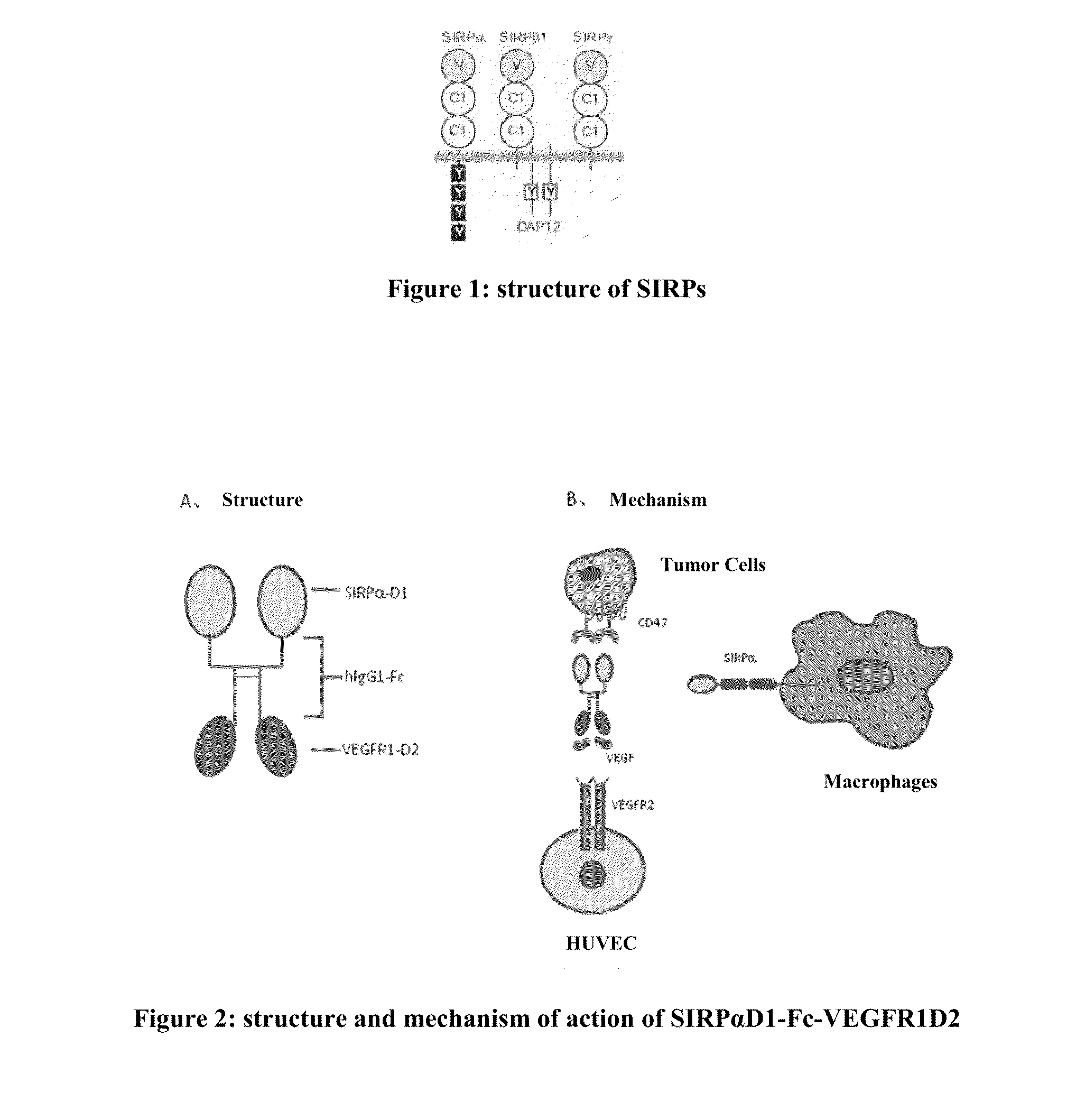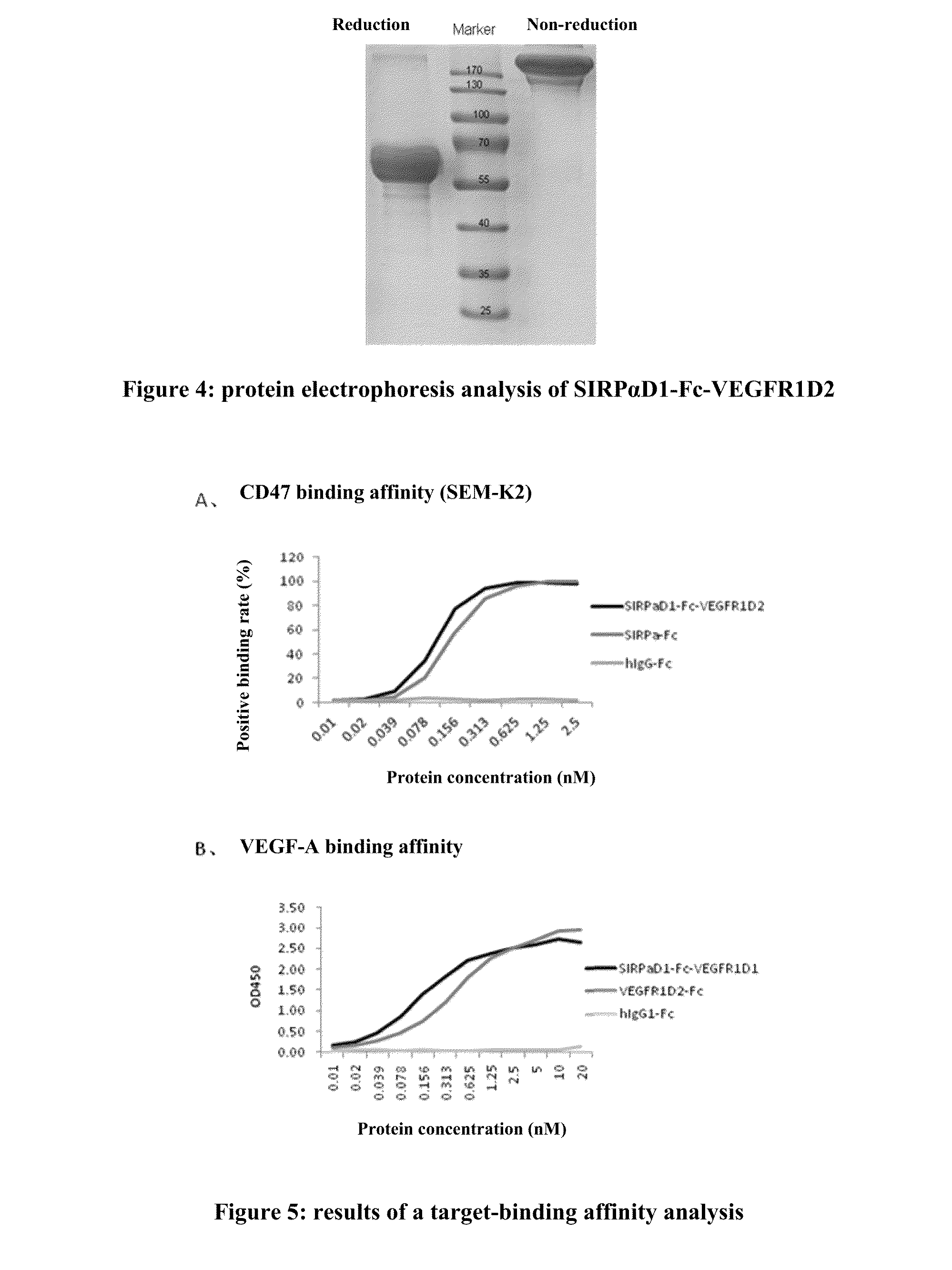Novel recombinant bi-functional fusion proteins, preparation and use thereof
a fusion protein and bifunctional technology, applied in the field of recombinant bifunctional fusion protein, preparation, can solve the problems of inhibiting cancer cell growth to a certain extent, and not being able to eliminate cancer cells
- Summary
- Abstract
- Description
- Claims
- Application Information
AI Technical Summary
Benefits of technology
Problems solved by technology
Method used
Image
Examples
example 1
SIRPαD1-Fc-VEGFR1D2 Binds to CD47 and VEGF, and Inhibits HL60 Tumor Growth
[0083]1. Construction of SIRPαD1-Fc-VEGFR1D2 Expression Vector
[0084]Plg-Tail (R&D Systems) was employed. Before cloning, Plg-Tail was engineered, by amplifying the Fc encoding sequence with primers 1 and 2, deleting the stop codon at the carboxyl terminal of Fc, and cloning the PCR product into the EcoRI / XhoI site in plg-Tail. The encoding sequence for SIRPαD1 was amplified with primers 3 and 4 from the THP-1 (ATCC® TIB-202™) cells, and the encoding sequence for VEGFR1D2 was amplified with primers 5 and 6 from the HUVEC (ATCC® PCS-100-010™) cells. The two PCR products were cloned into the HindIII / EcoRI and XhoI / XbaI sites in the engineered plg-Tail vector, respectively, thus generating vector pSIRPαD1-Fc-VEGFR1D2.
TABLE 1PCR primersPrimer sequenceendo-No.(5′-3′)targetnucleasePrimer 1:CGGAATTCGAGCCCHumanEcoRIAAATCTTGTGIgG1(SEQ ID No: 1)primer 2:CATGCTCGAGTTTAHumanXhoICCCGGAGACAGGGAIgG1(SEQ ID No: 2)primer 3:CCCA...
example 2
MAC-01 Inhibits Lung Cancer (A549) Growth
[0113]The above recombinant Fc-fusion protein SIRPAD1-Fc-VEGFR1D2 (MAC-01) was tested on an A549 Lung Cancer Xenograft model. The A549 cell line was first developed in 0.1972 by D. J. Giard, et al. through the removal and culturing of cancerous lung tissue in the explanted tumor of q 58-year-old caucasian male[10][11]. The A549 xenograft mouse model has been extensively used for efficacy evaluation of many drug candidates[12-15]. Experimental data indicated that MAC-01 can simultaneously bind with both VEGF and CD47 and thus can block respective molecule-mediated signals. When investigated in in vivo lung cancer xenograft model, MAC-01 exhibits a strong anti-tumor activity that is clearly better than that of combination of the single molecules.
[0114]Balb / c nude Mice were injected subcutaneously with 5×106 A549 cells in 200 μL of serum-free medium / matrigel (50:50 v / v). When the average tumor volume reaches 100-200 mm3, 30 mice bearing tumors o...
PUM
| Property | Measurement | Unit |
|---|---|---|
| Fraction | aaaaa | aaaaa |
| Fraction | aaaaa | aaaaa |
| Fraction | aaaaa | aaaaa |
Abstract
Description
Claims
Application Information
 Login to View More
Login to View More - R&D
- Intellectual Property
- Life Sciences
- Materials
- Tech Scout
- Unparalleled Data Quality
- Higher Quality Content
- 60% Fewer Hallucinations
Browse by: Latest US Patents, China's latest patents, Technical Efficacy Thesaurus, Application Domain, Technology Topic, Popular Technical Reports.
© 2025 PatSnap. All rights reserved.Legal|Privacy policy|Modern Slavery Act Transparency Statement|Sitemap|About US| Contact US: help@patsnap.com



